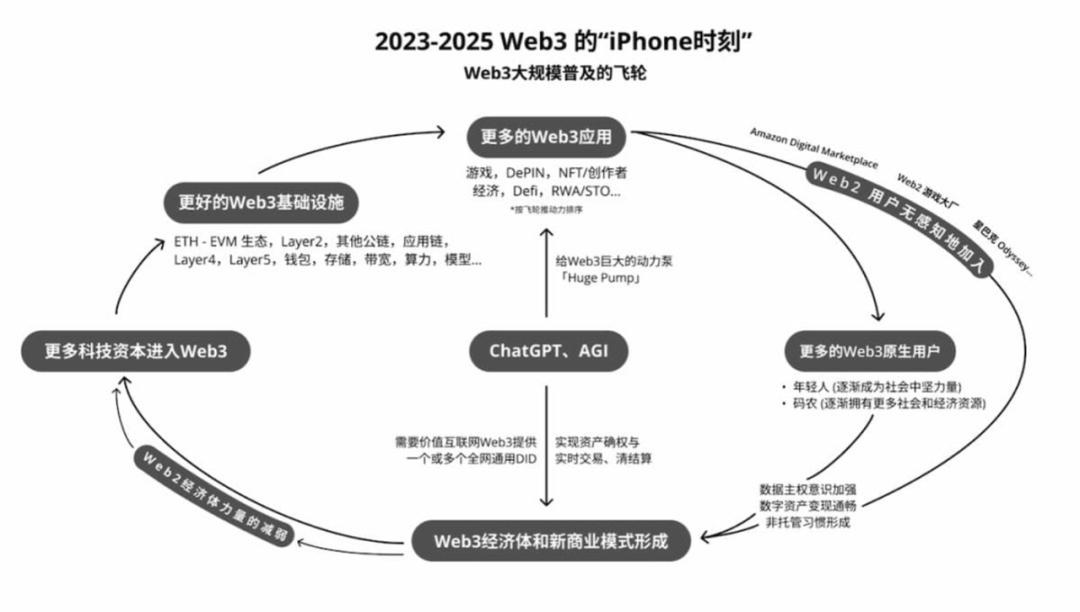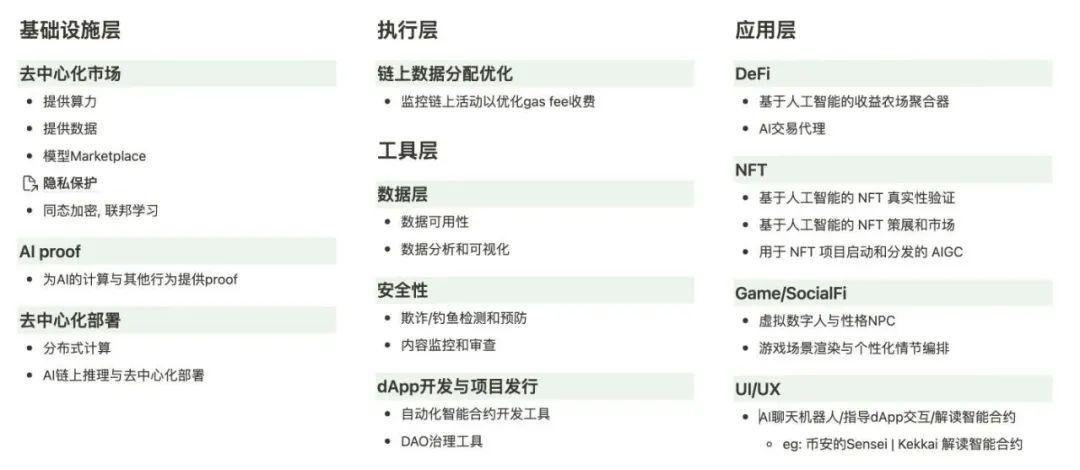OP Crypto Research Report: The Infinite Imagination of the Combination of AI and Web3
Source: OP Crypto
As a Web3 practitioner swept up by the wave of AI, after experiencing the information explosion in the industry over the past few months, I have整理了一些感想和研究想和 Web3从业者一起共勉:
AI and Web3, one breaking through our imagination of productivity limits, the other reshaping our understanding of economic models. As cutting-edge technologies representing future development directions, the combination of the two seems natural, always inspiring infinite imagination. However, when we turn our attention to reality, we find that there are very few projects that truly combine the two organically. The collision of the two tracks has given birth to new narratives, but it has also spawned many bubbles and gimmicks. Many beautiful visions that theoretically complement each other may not have real demand in reality; while those projects that can align with real needs may struggle to land due to cost or technological bottlenecks.
I believe that the idea of Web3 and AI being mutually beneficial is also proportional to the number of AI-infused Web3 projects seen in the primary market and the encounter with unnecessary Web3-ified AI projects. AI-native entrepreneurs/projects do not actually think about how to Web3-ify, such as data rights on-chain, economic models, production relationship distribution, etc., because the high resource demand of AI large models makes both training and operation highly centralized. Meanwhile, I remain very cautious about the actual feasibility of some Web3 projects claiming to help AI improve production relationships.
The Web3 market is facing significant bottlenecks both in macro policy and innovation. New regulatory pressures aside, from an innovation perspective, when AI rapidly enhances productivity and replaces human cognitive abilities, capturing the attention of most users, builders, and investors, the innovation dilemma in the Web3 industry becomes even more apparent. Web3 has not seen innovation at the level of AI for quite some time. To be honest, most new projects that have attracted attention recently are merely slight modifications of past technologies/products. For example, better staking methods, multi-chain wallets with improved user experience, meme coins with new gameplay, and Dexs with better liquidity on new public chains, etc. Do these so-called "innovations" really help bring in more users or increase the penetration of blockchain usage, and are they what the industry truly needs?
We need new areas that can bring AI into Web3 and allow Web3 to reach out, and the underlying essence of these blockchains, such as (1. content creation rights, 2. identity verification, 3. financial system innovation, 4. trustless termination, etc.), is crucial for the future paradigm shift of the entire industry. In the spirit of seeking organic integration, this article comprehensively reviews the new fields generated by the combination of AI and Web3, starting from the adaptation and complementarity of underlying technologies, and summarizes and analyzes the actual needs, development bottlenecks, and prospects of various directions within these fields.

The above image is referenced from Hash Global's KK boss
TL;DR
AI and Web3 have conflicts at the underlying logic level. The large resource requirements of AI models make AI highly centralized from training to operation, while the prospects of Web3 built on blockchain prioritize decentralization and transparency. This makes the underlying combination of AI and Web3 very difficult, and the validity of its business logic and the existence of actual demand remain to be scrutinized.
However, it is precisely this contradictory logic at the foundational level that allows AI and Web3 to complement each other, not seeking to become each other's narrative core but to become solutions to each other's pain points, propelling their respective developments. The two technologies will also bring many new narratives to each other, leaving a vast space for imagination. The economic model design of Web3 can help many AI project parties improve capital utilization to drive project user acquisition and engagement, while the benefits of blockchain itself, such as reducing infrastructure costs, verifying identities, injecting democracy and transparency into the data black box of artificial intelligence, and providing data contribution incentives, can offer new ideas for AI project teams' product design.
At the infrastructure level, the decentralized mechanism of Web3 can fundamentally address the risks and issues currently faced by AI, such as privacy protection and data misuse.
Providing a decentralized market for essential elements for AI development, such as computing power and data, maximizing the utilization of idle resources, optimizing resource use and allocation, and promoting the development and application of AI large models.
The decentralized mechanism of Web3 allows AI to become more democratic from the most fundamental aspects. Through decentralized deployment, training, and use of AI, user data privacy can be better protected while also providing opportunities for users to earn rewards by sharing data.
Blockchain can also be used to record and monitor AI behavior, thereby enhancing AI security and promoting the use of automated AI agents in various scenarios.
At the application layer, AI can help the development and popularization of Web3 applications.
Firstly, AI as a productivity tool can significantly improve the development speed of Web3 applications, while as a knowledge engine, it can reduce the interaction and learning costs for users with dApps, helping more users enter Web3.
AI can significantly lower the technical barriers for developing dApps and launching projects, allowing project competitiveness to focus more on innovation and operations. It is in this direction that generative AI can bring new narratives to Web3 applications, such as embedding virtual humans, character AI, and other innovative elements in gaming and social ecosystems, creating entirely new gameplay.

Infrastructure Layer
Token Incentives and Governance Mechanisms: Decentralized Market Empowering AI Infrastructure
In the era of AI large models, the various components supporting AI development will become particularly important.
A key challenge in building and developing AI infrastructure is how to effectively incentivize and coordinate participants to jointly promote the development and operation of the system. Decentralized markets and token incentive mechanisms provide a novel and powerful approach to solving this problem. In such a market, tokens serve as a digital asset and value medium, playing an important role. Tokens can represent specific rights, functions, or resources, and their transactions and transfers are conducted through smart contracts, achieving secure, transparent, and automated trading processes.
For AI infrastructure, token incentive mechanisms can play multiple roles. Firstly, tokens can serve as an incentive tool to reward and encourage participants who contribute to AI infrastructure. These contributions can include providing computing resources, datasets, algorithm models, computing power, etc. For example, the recently popular AI voice chatbot creation platform MyShell has achieved a data flywheel effect through a chatbot creation workshop and data analysis. Users can customize the voice, functions, and knowledge base of the chatbot on the MyShell platform and interact with it. The data collected from these interactions is used to improve the performance and personalized services of the chatbot, attracting more users to the platform and further increasing data and value, forming a virtuous cycle of growth.
By providing token rewards to participants, the economic model of Web3 can also attract more people to participate in the construction of AI infrastructure, promoting resource sharing and collaboration. Tokens can be used to facilitate value flow and exchange in decentralized markets. Participants can use tokens to buy and sell resources, services, and algorithm models, achieving transactions and collaboration in the market. This mechanism of value flow can provide a more flexible and efficient way for the development of AI infrastructure, enabling participants to better meet their respective needs and interests.
Homomorphic Encryption and Federated Learning: Integrating Privacy Protection into AI's Underlying Training
Ensuring personal privacy and data security while effectively training models has long been a challenge. In this regard, homomorphic encryption technology provides a powerful privacy protection method that can integrate privacy protection into the underlying training of AI, ensuring the security of sensitive data.
Homomorphic encryption is a special encryption technology that allows computations to be performed on encrypted data without the need for decryption. This means that model training and computations can be performed on encrypted data without exposing the content of the original data. By applying homomorphic encryption to the underlying training process of AI, privacy protection can be achieved without disclosing sensitive data.
When using homomorphic encryption for AI training, here are some key steps and considerations:
Data Encryption: Encrypt the data participating in AI training using homomorphic encryption algorithms. This ensures the privacy and confidentiality of the data during the training process.
Encrypted Computation: Perform computational operations in an encrypted state, including model training, optimization, and inference. Homomorphic encryption technology makes these computations possible without decrypting the data.
Secure Parameter Sharing: Parties involved in the training need to share and exchange secure parameters required for encrypted computations. These parameters are used to control the homomorphic encryption process and decrypt the results.
Encrypted Result Processing: After completing the encrypted computations, the results can be decrypted to obtain the final model weights or prediction outputs. Appropriate security measures should be taken when decrypting results to prevent data leakage or unauthorized access.
The integration of homomorphic encryption technology into the underlying training of AI has several advantages and potential application scenarios:
a. Privacy Protection: Homomorphic encryption makes it possible to train models on sensitive data without actually accessing or exposing that data. This helps maintain personal privacy and the control of data owners.
b. Data Collaboration: Multiple data owners can jointly participate in AI training without sharing their original data. Homomorphic encryption technology makes such data collaboration possible, promoting opportunities for cooperation and sharing.
c. Legal Compliance: For sensitive data subject to legal and regulatory restrictions (e.g., medical records or financial data), homomorphic encryption provides a method for AI training that meets compliance requirements.
This type of privacy can also be achieved through decentralized computing platforms. For example, Fluence is a decentralized computing platform that can run many programs, including AI, aiming to achieve digital innovation freedom through peer-to-peer applications. It provides an open Web3 protocol, framework, and tools for developing and hosting applications, interfaces, and backends on a permissionless peer-to-peer network.
zkML and On-Chain AI Inference: Monitoring AI Agent Behavior and Accountability Constraints
In the context of the rapid development and widespread application of artificial intelligence (AI) technology, ensuring that AI systems behave in accordance with ethical and legal requirements has become particularly important. AI systems are often viewed as agent entities capable of performing tasks and making decisions, and these decisions can have profound impacts on humans and society. Therefore, monitoring AI agent behavior and constraining their accountability has become a key issue in safeguarding public interest and individual rights. zkML, as an innovative approach, provides a secure, verifiable, and transparent solution for monitoring AI agent behavior and accountability constraints. By combining zero-knowledge proofs and blockchain technology, zkML ensures compliance and credibility of AI systems while protecting privacy.
Taking Modulus Labs as an example, this project utilizes zkML technology to ensure that no key data or sensitive information is leaked during the operation of AI systems. By applying zero-knowledge proofs during the computation process, the project can demonstrate to regulators or stakeholders that its AI has performed specific tasks without revealing the actual data or internal models. This approach protects personal privacy and business secrets while providing a means to audit and verify AI agent behavior. The decentralized monitoring and constraint framework established by zkML can monitor and review the decision-making processes and behavior paths of AI agents in real-time.
This decentralized monitoring mechanism ensures transparency and traceability, allowing violations or improper decisions to be detected and corrected in a timely manner. zkML also provides a mechanism for accountability constraints on AI agent behavior. By integrating smart contracts with the operation and decision-making processes of AI systems, a series of rules and conditions can be set to limit the behavior of AI agents and ensure compliance with ethical standards and legal regulations. This accountability constraint mechanism makes AI systems trustworthy tools that can create value for human society without abusing power or harming human interests. This technology lays an important foundation for building sustainable, ethical, and responsible AI systems.
Execution Layer
Improving Productivity, Accelerator for Web3 Development
In the development of Web3, artificial intelligence (AI) plays an important role, combining with various fields to improve productivity and create better user experiences. Here are several key areas where AI and Web3 intersect:
AI and On-Chain Data Collection and Analysis
AI technology plays a significant role in on-chain data collection and analysis. Blockchain, as a distributed database, records a large amount of transactions and information. By leveraging AI technology, we can better understand and utilize the data on the blockchain. For example, Web3 Analytics is an AI-based analytics platform that uses machine learning and data mining algorithms to collect, process, and analyze on-chain data. It can help users gain insights into on-chain transactions, market trends, and user behavior patterns, thus providing more accurate data analysis and decision support. Similar platforms include MinMax AI, which offers AI-based on-chain data analysis tools to help users discover potential market opportunities and trends.
AI and Automated dApp Development
The application of AI technology in the automated dApp development process is also very important. Smart contract and dApp development typically requires writing a large amount of code and going through tedious testing and deployment work. By combining AI with smart contract and dApp development tools, a more efficient and intelligent dApp development process can be achieved. AI can help automate code generation, validate and test smart contracts, and deploy and maintain dApps. This can save time and resources while improving the efficiency and accuracy of the development process. For example, some AI-assisted development tools use natural language processing and machine learning technologies to help developers write smart contracts faster and automatically detect and fix potential errors.
AI and On-Chain Transaction Security
In the Web3 world, on-chain transaction security is crucial. Due to the openness and transparency of blockchain, risks such as malicious attacks, fraud, and data breaches exist. AI technology can be used to enhance the security and privacy protection of on-chain transactions. For example, the Web3 security platform SeQure utilizes AI to detect and prevent malicious attacks, fraud, and data breaches, providing real-time monitoring and alert mechanisms to ensure the security and stability of on-chain transactions. Similar security tools include AI-powered Sentinel.
Optimizing Resource Allocation, Navigator in the Web3 World
In the Web3 world, optimizing resource allocation is a key challenge. With the combination of blockchain technology and artificial intelligence, we can leverage AI as a navigator to achieve more effective resource distribution and utilization. Here are several areas where AI plays a navigational role in the Web3 world:
AI and On-Chain Activity Optimization: On-chain activities include transactions, contract execution, and data storage. Through AI's intelligent analysis and predictive capabilities, we can better optimize on-chain activities and improve overall efficiency and performance. AI can help identify transaction patterns, detect abnormal activities, and provide real-time suggestions to optimize resource allocation in the blockchain network through data analysis and model training.
AI and On-Chain Advertising Mechanisms: In the Web3 world, advertising is also a form of resource. AI can play a key role in on-chain advertising mechanisms, helping advertisers more accurately target their audience and provide personalized ad content. By analyzing on-chain user data and behavior patterns, AI can achieve more precise ad placements, improving click-through rates and conversion rates, thereby optimizing resource allocation and utilization.
AI and DAO Governance: Decentralized Autonomous Organizations (DAOs) are a new form of organization in the Web3 world. AI can serve as an important tool for DAO governance, assisting in decision-making, voting mechanisms, and community governance. AI can help DAO members better understand community needs and opinions through data analysis and predictions, providing decision support. With AI's involvement, DAOs can operate more efficiently, optimize resource allocation, and promote community development and growth.
Application Layer
Lowering Barriers to Entry, Accelerator for Web3 Popularization
User-Friendly Interfaces Embedded with AI
For example, the Web3 auditing platform Fuzzland uses AI to help code auditors check for code vulnerabilities, providing natural language explanations to assist auditing expertise. Fuzzland also utilizes AI to provide natural language explanations of formal specifications and contract code, along with some example code, to help developers understand potential issues in the code. By combining AI technology with auditing expertise, Fuzzland enables developers in the Web3 industry to more easily understand and interpret code, improving the efficiency and accuracy of audits.
AI-Embedded Smart Contract Interpretation
AI-Embedded Smart Contract Writing
In the development of Web3, lowering barriers to entry is key to achieving widespread adoption. To achieve this goal, the integration of artificial intelligence (AI) technology plays an important role in providing user-friendly interfaces, smart contract interpretation, and smart contract writing. User-friendly interfaces embedded with AI provide users of Web3 platforms with a more intuitive and convenient operating experience. Traditional blockchain technology often requires users to learn complex commands and syntax to interact and execute operations. However, by applying AI technology to user interface design, features such as natural language processing and graphical interfaces can be implemented, allowing users to easily use Web3 platforms for various operations without needing to delve into technical details. AI also provides users with a better understanding and interpretation of smart contracts. By applying AI technology, automatic parsing and visual display of smart contracts can be achieved, clearly presenting the logical processes and conditions within smart contracts to users, enhancing their understanding and trust in smart contracts.
Enriching Gameplay, Creative Repository of the Web3 World
AI and Generative NFTs
AI Automated Trading Agents
Character AI and Game NPCs
AI and Automatic Rendering of Metaverse Scenes
The rise of generative AI has brought new possibilities to the creative industry, offering more diverse and innovative experiences in the Web3 world, allowing users to participate in rich narratives and gameplay. During the past NFT bull market, AI injected infinite creativity into generative NFTs. Generative NFTs (Non-Fungible Tokens) are artworks or digital assets based on algorithms and data, and through AI technology, various unique and diverse artworks and characters can be generated. These generative NFTs can become characters, props, or scene elements in games, virtual worlds, or the metaverse, providing users with rich choices and personalized experiences. During the DeFi boom, AI automated trading agents also brought convenience and efficiency to the economic trading processes within the creative repository. In the Web3 world, users can earn profits by owning, trading, or participating in digital assets within the creative repository. AI automated trading agents utilize intelligent algorithms and machine learning technologies to automate asset trading, helping users seize the best trading opportunities and maximize profits.
AIGC has also brought new gameplay and creativity to content platforms and UGC communities. For example, Yodayo is an AI art platform for virtual streamers and anime fans to share and create more content they love. Yodayo integrates the AIGC engine, making content creation and interaction on the platform easier for users, allowing the majority of users who are typically "silent" on traditional platforms to become creators and contributors, transforming from content consumers into content creators, fostering closer connections with the community.
The combination of character AI and game NPCs brings a more realistic and interactive experience to the narratives within the creative repository. By applying AI technology to game characters and non-player characters (NPCs), they can be endowed with intelligent behavior, autonomous decision-making, and emotional expression capabilities. This enriches the game narrative, allowing players to interact with characters possessing realistic artificial intelligence, exploring the game world and solving various challenges together. The integration of AI with automatic rendering of metaverse scenes creates a more realistic and vivid environment within the virtual world of games. For example, Inward AI systematically analyzes player behavior and preferences, providing unique tasks or information from key characters in the game based on their previous interactions, shaping personalized storylines for each player. Meanwhile, the real-time combat AI provided by rctAI makes every battle come alive, with characters battling against players continuously learning from their combat strategies, improving skills, and adjusting strategies, adding more uncertainty and excitement to the battles. The integration of these AI technologies creates dynamic and interactive narratives, realistic and challenging combat scenes, making the game world more immersive and engaging.
Conclusion
As Web3 practitioners swept up by the wave of AI, we have gained deeper insights into the combination of AI and Web3 after experiencing the information explosion of both industries in recent months. Although there are conflicts in underlying logic, the centralized nature of AI and the decentralized principles of Web3 seem difficult to reconcile, it is precisely this contradictory logic that allows AI and Web3 to complement each other, becoming solutions to each other's pain points and mutually promoting their development. The decentralized mechanisms of Web3 can fundamentally address issues such as privacy protection and data misuse faced by AI, while the application of Web3 and blockchain technology can also monitor and record AI behavior, enhancing AI security and promoting the adoption of automated AI agents across various fields.
While the combination of AI and Web3 faces numerous challenges, it can create many new possibilities and narratives at the application level: AI can become an important driving force for Web3 applications, significantly improving the development speed of Web3 applications, reducing interaction and learning costs for users with dApps, and helping more users enter the Web3 world. At the same time, while AI lowers the technical barriers for dApp development and project launches, it can also bring more innovative gameplay and enhance competitiveness in innovation and operations, such as embedding virtual humans and character AI in gaming and social ecosystems, bringing new narratives and experiences to Web3 applications, further promoting the development and popularization of the Web3 industry.
Despite the challenges and limitations faced by the combination of AI and Web3, we believe that only through their organic integration can the narratives and ideals of the next generation of the internet be supported. We look forward to seeing more innovative projects that can bring AI into Web3 and push Web3 into broader fields, and we hope that the development of these two cutting-edge technologies can continuously help each other break through technological bottlenecks and overcome cost constraints, jointly creating a smarter and more open future.








